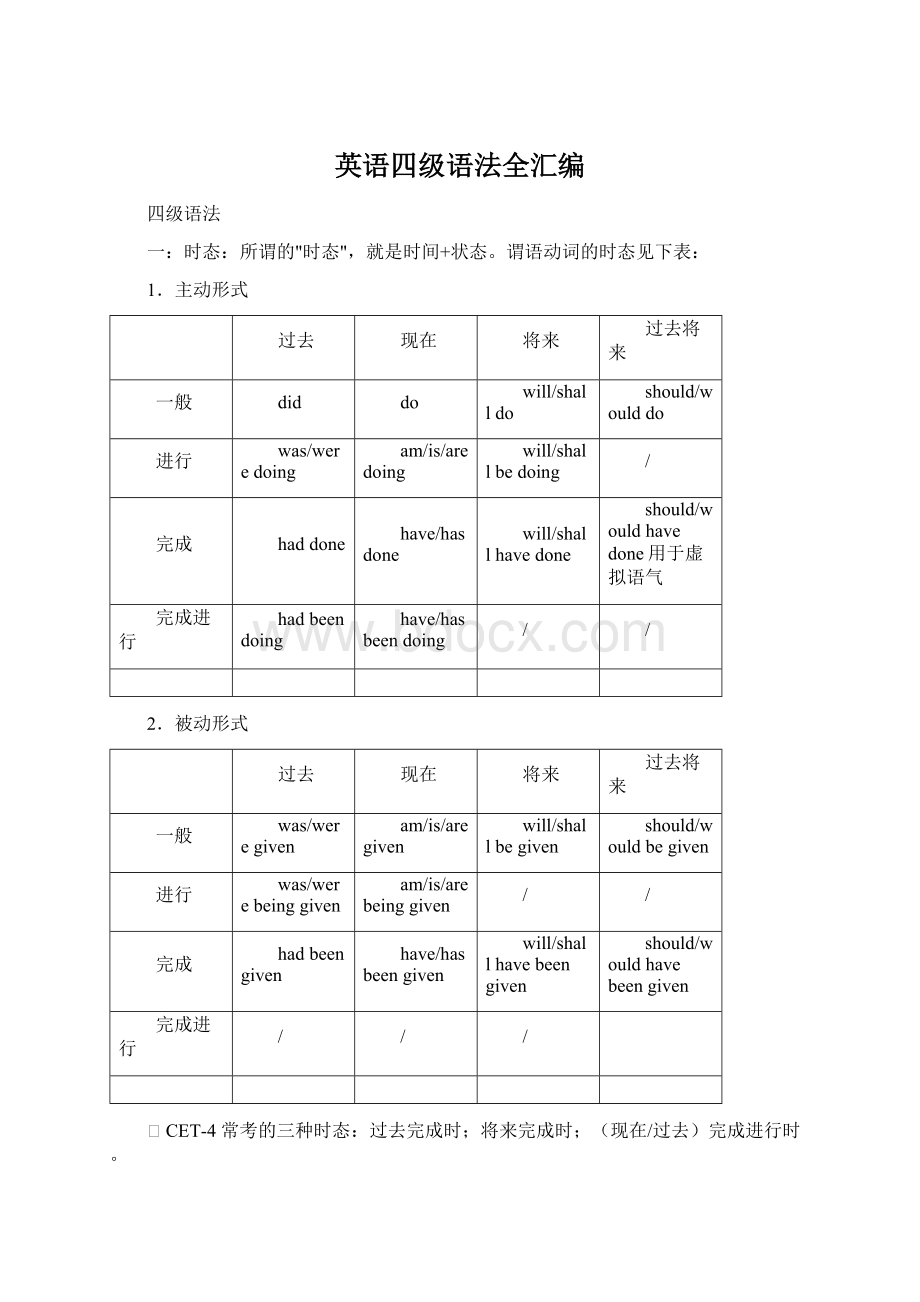英语四级语法全汇编.docx
《英语四级语法全汇编.docx》由会员分享,可在线阅读,更多相关《英语四级语法全汇编.docx(15页珍藏版)》请在冰豆网上搜索。

英语四级语法全汇编
四级语法
一:
时态:
所谓的"时态",就是时间+状态。
谓语动词的时态见下表:
1.主动形式
过去
现在
将来
过去将来
一般
did
do
will/shalldo
should/woulddo
进行
was/weredoing
am/is/aredoing
will/shallbedoing
/
完成
haddone
have/hasdone
will/shallhavedone
should/wouldhavedone用于虚拟语气
完成进行
hadbeendoing
have/hasbeendoing
/
/
2.被动形式
过去
现在
将来
过去将来
一般
was/weregiven
am/is/aregiven
will/shallbegiven
should/wouldbegiven
进行
was/werebeinggiven
am/is/arebeinggiven
/
/
完成
hadbeengiven
have/hasbeengiven
will/shallhavebeengiven
should/wouldhavebeengiven
完成进行
/
/
/
vCET-4常考的三种时态:
过去完成时;将来完成时;(现在/过去)完成进行时。
v时间状语从句当中的时态:
一般过去时所有的过去
用一般现在时表示现在和将来
现在完成时现在完成和将来完成
一.非谓语动词
一.不定式:
一)不定式的常考形式:
1)一般形式:
Hedecidedtoworkharderinordertocatchupwiththeothers.
被动形式:
Hepreferredtobeassignedsomeheavierworktodo.
语法功能:
表示与谓语动词同步发生
2)完成形式:
Hepretendednottohaveseenme.
被动形式:
Thebookissaidtohavebeentranslatedintomanylanguages.
语法功能:
表示发生在谓语动词之前
二)不定式常考的考点:
1)不定式做定语----将要发生
2)不定式做状语----目的
3)不定式充当名词功能---Toseeistobelieve.
三)不定式的省略
1)感官动词see,watch,observe,notice,lookat,hear,listento,smell,taste,feel
+do 表示动作的完整性,真实性;
+doing表示动作的连续性,进行性
Isawhimworkinthegardenyesterday.
昨天我看见他在花园里干活了。
(强调"我看见了"这个事实)
Isawhimworkinginthegardenyesterday.
昨天我见他正在花园里干活。
(强调"我见他正干活"这个动作)
v感官动词后面接形容词而不是副词:
Thecaketastesgood;Itfeelscomfortable.
2)使役动词havebidmakelet等词后不定式要省略但同1)一样被动以后要还原to
I‘dliketohaveJohndoit.
Ihavemypackageweighed.
Pauldoesn’thavetobemadetolearn.
3)helphelpsbdohelpsbtodohelpdohelptodo
四)有些动词后只跟不定式如:
want,wish,hope,manage,promise,refuse,pretend,plan,offer,decide,agree,expectallowsbtodo,causesbtodo,permitsbtodo,enablesbtodo
forcesbtodo.bemorelikelytodolovetodowarnsbtodobeabletodo
beambitioustodo.begintodo.starttodo
五)有的时候to后面要接-ing形式
accustom(oneself)to;beaccustomedto;faceupto;inadditionto;lookforwardto;objectto;bereducedto;resignoneselfto;beresignedto;resortto;sinkto;beusedto;bealternativeto;beclose/closenessto;bededication/dedicatedto;beopposition/opposedto;besimilarity/similarto.
三、need/want后的-ing形式具有被动的意思。
其中,want不太常用。
Heneeds(alotof)encouraging.
二.动名词:
具有动作性特征的名词
1)是名词seeingisbelieving
2)具有动词性特征可以带宾语starvingtroopsisnecessary.
一)动名词的形式:
一般形式:
Idon'tlikeyousmoking.
完成形式:
Iregretnothavingtakenyouradvice.
被动形式:
Thisquestionisfarfrombeingsettled.
二)动名词常考的点
1)动名词做主语谓语动词为单数
2)在动名词和不定式中,做为介词的宾语是动名词
3)动名词的否定直接在其前加否定词,通过代词的宾格或所有格形式给出逻辑主语.
Iwouldappreciate_______backthisafternoon.
A.youtocallB.youcallC.youcallingD.you'recalling(Key:
Cyourcalling也对)
Iregretnothavingtakenyouradvice.
4)有些词后只能接动名词
admit;appreciate;avoid;celebrate;consider;contemplate;defer;delay;deny;detest;discontinue;dislike;dispute;enjoy;itentails;escape;excuse;explain;fancy;feellike;finish;forgive;can'thelp;hinder;imagine;itinvolves;keep;itmeans;mention;mind;miss;itnecessitates;pardon;postpone;practice;prevent;recall;report;resent;resist;risk;suggest;understand...
另外还有一些接-ing形式的常用说法:
it'snogood;it'sno/little/hardlyany/use;it'snot/hardly/scarcelyuse;it'sworthwhile;spendmoney/time;there'sno;there'snopointin;there'snothingworsethan;what'stheuse/point...
5有些词后加不定式和动名词均可
remember,forget,try,stop,goon,cease,mean后面用不定式和-ing形式,意义截然不容。
Irememberedtoposttheletters.(指未来/过去未来的动作)
Irememberedposting/havingpostingtheletters(我记得这个动作)
forgot与remember的用法类似。
Iregrettoinformyouthat…我很遗憾地通知你…
Iregrettedhavingleftthefirmaftertwentyyears.为了"二十年前的离开"而遗憾。
tryto努力Youreallymusttrytoovercomeyourshyness.
try–ing试验Trypracticingfivehoursaday.
Imeantogo,butmyfatherwouldnotallowmeto.[打算、想]我想去,但我父亲不让我去。
Toraisewagemeansincreasingpurchasingpower.[意味着]赠加工资意味着增加购买力。
prefer的用法:
我宁愿在这里等。
Iprefertowaithere.(所以啊,你不介意的话,我就等下去。
)
Ipreferwaitinghere.(我正在这里等,我就喜欢这么做。
)
Ipreferswimmingtocycling.(这个句子里面就不能用不定式了。
)
3分词:
现在分词主动进行,过去分词被动状态
现在分词的形式:
1)一般式:
Doyouseethemantalkingtothedean(主任)?
(与谓语动词同步发生)
2)完成形式:
Nothavingmadeadequatepreparations,theyfailed.(发生谓语动词之前)
3)完成被动形式:
Havingbeenadapted,thescriptseemsperfect.(发生谓语动词之前且表示被动)
过去分词
1)过去分词表示被动:
Fightnobattleunprepared.
2)过去分词的进行形式:
You'llfindthetopicbeingdiscussedeverywhere.(强调正在被做)
这三种非谓语动词,都可以构成复合结构,非谓语动词所修饰的成分是这些非谓语动词的逻辑主语。
他们之间的一致关系——主动还是被动,往往就是考点。
独立主格结构中,要注意的是分词与他前面的逻辑主语之间的主动被动的关系。
二:
虚拟三:
虚拟语气
情态动词所表达的可能性程度:
must/can't→should/shouldn't→might/may(not)
另外两个"类情态词的形式:
"need/needn't;haveto/don'thaveto
v最自然的虚拟状态:
由should/would+原型时态(不含时间只含状态)
本质上是过去将来时:
即,时间固定在过去将来,状态不同:
一般、进行、完成、完成进行。
这时"虚拟语气"的产生往往是因为我们要表达"本来应该……"(而现在却还没有……)
(本来可以……,本来能……)
Ishouldgo!
(…butI'mstillhere!
)(一